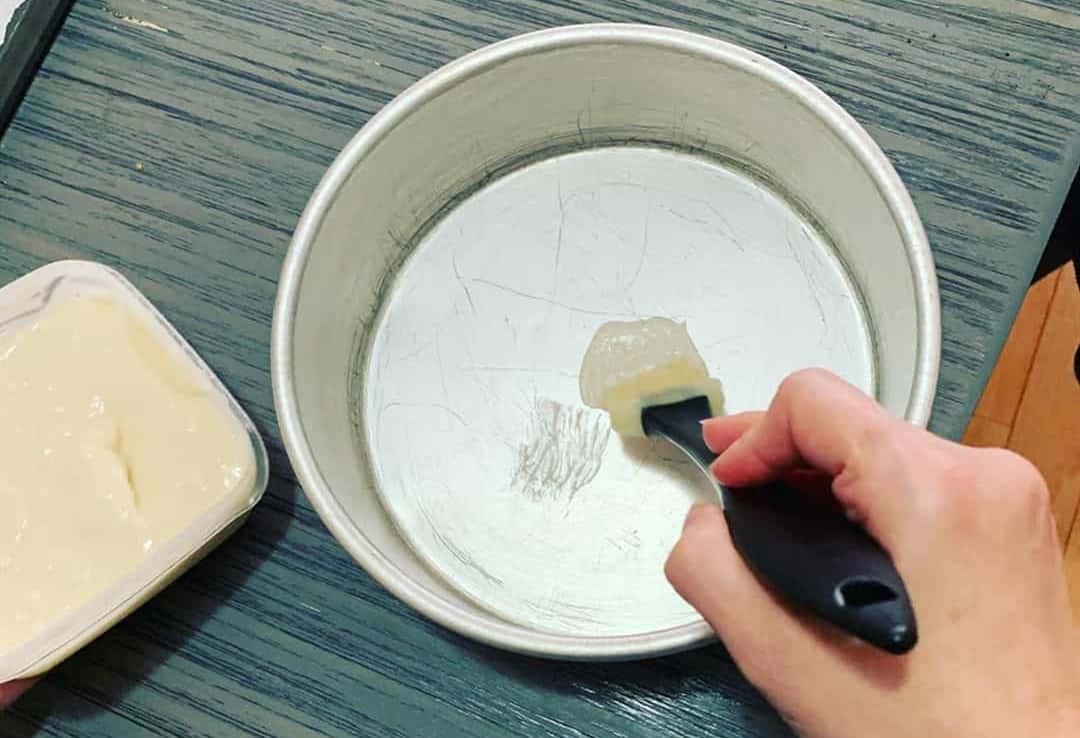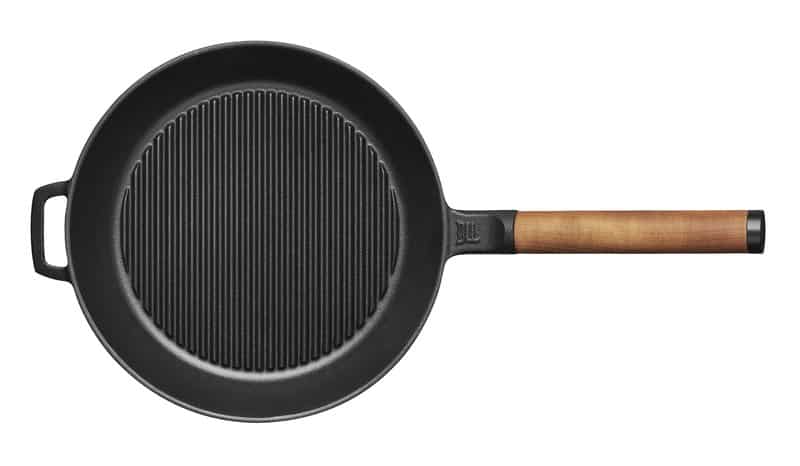Many recipes will show you how to put the dough to a baking pan, but not precisely how to grease your dish adequately. Although it seems it is an effortless task, you shouldn’t skip this step since it can make a difference in the end.
If you don’t oil the pan properly, you won’t be able to remove the crust or cake without damage. It will probably stick to the surface or break into pieces.
There are several ways to grease a pan properly. Which one you want to use will depend on what you bake and what kind of cookware you have. That means baking a cake, cookies, and loaf bread require different greasing. Also, springform pan and roasting pan need a different approach. Let’s see how to grease a pan.
This article will cover
- Methods of Greasing a Pan.
- Greasing Different Types of Pans.
- Seasoning the New Pan.
- Summary.
Methods of Greasing a Pan
1. Butter and flour
The traditional way to grease a cake pan is to run butter all over its surface with your fingers. It includes both the bottom and all the sides. The heat from the fingers will soften the butter and make the job quicker. Then, you should add a pinch of flour, shake and tap the pan to spread it evenly.

Pour the rest of the flour out from the pan, and you are ready to put the dough in. Some bakers like to use a brush or kitchen paper instead of fingers, which spreads the butter on the surface evenly. Whatever method you decide to pick out, try not to leave any uncovered gaps or crumbs of butter inside.
Also, take care to grease the pan right before you finish with the dough. If it is impossible for some reason, you should keep the greased pan in the fridge until using it. Leaving the pan at room temperature will result in melted butter, which is not suitable for baking.
In case you make a bread loaf, you can try coarse cornmeal on the butter instead of flour. It will create a crispy crust to your bread, and it will be more comfortable to get it out of the pan.
2. Butter and sugar
In some cases, adding sugar over the butter instead of flour is an excellent way to get the cake out of the pan effortlessly.
However, that will depend on the recipe. The sugar coating will make the crunchy crust on some cakes, but it is not the best option for layer cakes.
3. Vegetable shortening and oil

You can also use vegetable shortening instead of butter. It is a hydrogenated vegetable oil made of palm or soybean oils. It is stable at room temperature, and it has a neutral flavor. Since vegetable shortening allows high temperatures while preparing the food, you can use it for baking pies, cookies, and pizza crusts.
If you decide to use it, the best option is to evenly apply the layer of grease over the pan bottom with kitchen paper. Then, sprinkle the pan with flour, and it will be easy for you to take out the cake from the pan once it is finished. Keep in mind that vegetable oil is not convenient for all types of cakes.
4. Parchment paper (baking paper)

This non-sticking cellulose silicone-coated paper comes in a roll or sheet. Choose the most convenient one according to the size of your pan to make your baking more comfortable. You can always cut it when you need a smaller paper size.
In some recipes, parchment paper doesn’t require additional grease and flour. When it comes to cakes, you should grease the paper and sprinkle with flour once you place it in the pan.
If your pan is round-shaped, there are two ways to cut the paper to adequate circle size. Place the dish on the paper and draw a line around it with a pen. Then, cut along the drawn line.
You can also fold the parchment paper and create a form of a triangle. Fold it a few more times to create a pointed shape. Then, place the tip of the paper in the center of the pan, measure the length towards the edge, and cut off the rest of it. Unfold it, and you will get almost the perfect circle for your pan.
Make sure not to mix the parchment with wax paper. Since this paper is coated, the wax will melt and soak into the cake once you put it in the oven.
5. Oil spray

The latest invention, which helps with cooking and baking, is oil spray. It is easy to use and efficient when it comes to uneven surfaces, such as Bundt pan.
In the beginning, there was only one version of oil spray. Later, it was upgraded to an oil and flour product. Nowadays, you can find coconut, avocado, canola, and olive oil spray for different pans and purposes.
Greasing Different Types of Pans
Non-stick pan

Non-stick pans require specific maintenance because damaging the protective layer will result in loss of their non-stick properties. It’s important to avoid using these pans at extremely high temperatures.
While some recommend using oil or butter, it’s best to use minimal amounts if necessary, as too much can result in the food absorbing the oil, which could be unhealthy. That way, the oil will keep your food soft without filling it with unhealthy fats.
Carbon steel pan

This kind of pan will need seasoning before you use it for the first time. After washing it, you should heat the carbon steel pan in the stove. Then, put oil in and wait until it starts smoking, and the color of the pan turns brown. Remove the residues with a paper towel and use your cookware without too much greasing in the future.
Grill pan

Since the grill pan has an uneven surface, you should preheat it to prevent the food from sticking to the surface. Then, spread the oil evenly with a paper towel or use the oil spray. You can’t pour the oil into the pan since it will end up in the grooves in such a case.
Springform pan

Springform pan consists of two parts:
- The outer collar with the latch to open and close
- The bottom that fits inside the collar when you close the latch
It is ideal for cheesecakes and pies. Grease it with butter and flour or spray oil, according to your recipe. Even though most manufacturers claim that this pan doesn’t stick, you should still take some precautions just in case.
So, go along the inside edge of the pan with a knife before opening the latch. That way, you will prevent any part of the cake from sticking to the side.
Seasoning the New Pan

Keep in mind that a new non-stick pan always comes with a protective layer. You need to remove it with warm water and soap before using it for the first time. After that, the recommendation is to season them. Apply a protective layer of grease to prevent the pan surface from roasting and food from sticking.
With cast iron pan and carbon steel pan, greasing the surface is necessary to prevent the forming of rust when the material comes in touch with water and food. Also, the seasoning will protect the food from sticking to a pan bottom while cooking. Let’s take a closer look.
One-time seasoning of the new pan is an excellent way to avoid burnt leftovers and prevent annoying scrubbing and rubbing the pan after cooking. However, you can repeat the procedure several times.
That way, you will form a thick layer of protection and make baking an enjoyable task. There are necessary steps you should follow to protect both your food and your pans:
1 step – As I have already mentioned, most new pans are previously coated with a protective layer, like beeswax. You need to remove this film with soapy water before starting with seasoning.
2 step – Dry your pan with a cloth or paper towel. You can also leave it in the medium-heated oven to let the water entirely evaporate.
3 step – Apply a layer of grease all over the pan surface. You should use flaxseed or canola oil for that purpose. Keep in mind that the coat shouldn’t be too thick. It will be enough to cover the surface evenly.
4 step – Then, put the pan in the oven, turn it upside down, and leave it on 450 F (232 C) for about 30 minutes to an hour. The oil will heat up and create the desired layer. Don’t forget to protect your oven by placing another pan under the new one to prevent the oil from dripping.
Summary
Nowadays, baking and cooking are not just primary skills. They are almost a form of art, so you can freely experiment and create your own unique meals. With a few high quality and well-maintained pans and healthy ingredients, you can enjoy every activity in your kitchen.


Michael Johnson is the founder of Pan Mastery, Inspired by his blacksmith grandfather’s legacy has a deep appreciation for hand-crafted pots and pans, he provides invaluable guides, reviews, and recipes to enhance your culinary journey.

